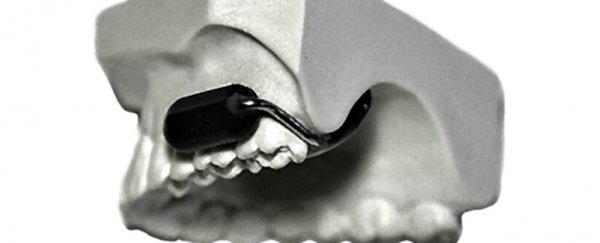A lot of military technology manages to be both awe-inspiring and vaguely terrifying, and so it is with the Molar Mic – this little microphone and speaker combination actually clips on to the wearer's back teeth. It's completely wireless and invisible to anyone else.
Despite its rather precarious position, the little device can pick up the speech of the wearer without any visible interface, and relay sound back through bone-conducting technology through the teeth and skull to the inner ear.
It is, apparently perfectly possible to hold a normal phone call conversation with this, though we haven't tried it ourselves.
And the potential uses for soldiers are many and varied: the Molar Mic allows for hands-free communication while driving, while hanging from the side of a mountain, while advancing through the jungle, while wearing a face mask, and even while underwater.
 (Sonitus Technologies)
(Sonitus Technologies)
The developer of the innovative gadget, Sonitus Technologies, has just been awarded millions of dollars of funding from the US military to get the Molar Mic ready for field work. Further down the line it could also be used by emergency responders.
"Sonitus Technologies is honored to bring this game changing technology to our country's elite military, making them safer and more effective by enabling them to communicate clearly – even in the most extreme situations," says Sonitus CEO Peter Hadrovic.
"The voice interface sustains communications in dangerous and challenging environments. The Molar Mic is the first in our family of solutions that conventional approaches are unable to address."
It's certainly unconventional – and the "extreme situations" Hadrovic mentions are perhaps where the Molar Mic will prove most useful, when it's just not practical to pull out a full walkie-talkie set.
The tiny mic isn't doing everything itself: it communicates wirelessly with a radio pack concealed somewhere else on the wearer's body, using a technology called Near-Field Magnetic Induction (NFMI). It's shorter range than most wireless communication systems, but it also uses less power.
By being situated in the mouth, its makers say, the Molar Mic can cut out external sounds from the microphone – whether that's the sound of helicopter blades or a torrential thunderstorm – ensuring the wearer can be heard.
When it comes to listening, the incoming sounds are converted into vibrations that the cochlea in the ear can convert back into sounds (similar technology is sometimes used in hearing aids too).
"The result is an unobstructed head and face, clear communication, higher comfort, enhanced situational awareness and the ability to add or remove personal protective equipment without breaking communication," says Sonitus.
The technology has already been tested and been given the thumbs up from pararescuemen in the Air National Guard 131st Rescue Squadron – they say it means voices can be heard when they would otherwise be drowned out by aircraft noise or the conditions of the environment.
No word yet on whether we'll be able to buy one of these to use with our smartphones, but watch out for people apparently talking to themselves on the street – they could be in the middle of a top-secret undercover operation, Molar Mic in place.
